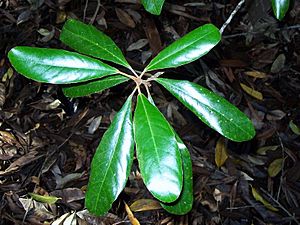Hairy quandong facts for kids
Quick facts for kids Hairy quandong |
|
|---|---|
 |
|
| Conservation status | |
| Scientific classification | |
| Genus: |
Elaeocarpus
|
| Species: |
williamsianus
|
The Hairy Quandong (scientific name: Elaeocarpus williamsianus) is a very rare tree found only in the rainforests of far north-east New South Wales, Australia. It's called "hairy" because of the fuzzy hairs on its trunk and branches! This special tree is in big trouble – only about 100 of them are left in the wild, growing in just three small areas near the town of Murwillumbah. Because there are so few, the Hairy Quandong is listed as an endangered species, meaning it's at high risk of disappearing forever. It likes to grow in areas where rainforests are regrowing, especially in warm, wet places.
Contents
What Does the Hairy Quandong Look Like?
The Hairy Quandong is a small tree. It can grow up to 15 metres (about 50 feet) tall. Its main stem can be about 18 centimetres (7 inches) wide.
Its Trunk and Branches
The tree's trunk is usually straight. It has bark that is a mix of brown and cream colours. The smaller branches of the tree are covered in reddish-brown hairs. This is where the tree gets its "hairy" name!
Its Leaves
The leaves of the Hairy Quandong are quite long, usually between 9 and 18 centimetres (3.5 to 7 inches). They are also about 2 to 5 centimetres (1 to 2 inches) wide. The leaves grow in a special way: they are alternate on the stem but often appear in small groups or clusters. They have a broad, spear-like shape.
The edges of the leaves have tiny teeth, but they are hard to see. The stalks that hold the leaves are about 23 to 32 millimetres (about 1 inch) long. The top side of the leaf is shiny green. But the underside is covered in rusty-brown hairs, just like the branches! Sometimes, tiny pockets called domatia can form where the leaf veins meet, but these are often hidden by all the hairs.
Flowers, Fruit, and Life Cycle
The Hairy Quandong has interesting flowers and fruit, which are important for its survival.
Flowers
Pale green flowers with five petals appear on the tree from November to December. These flowers grow in clusters called racemes, which are like small stalks covered in rusty-brown hairs. Each petal is about 12 millimetres (half an inch) long and has a fringed, or feathery, edge.
Fruit
After the flowers, the tree produces shiny blue fruits. These fruits are round, like a small ball, and are about 2 to 3 centimetres (1 inch) across. They look a bit like the fruit of the Blue quandong tree. The fruit usually ripens from April to December, but sometimes it can also ripen in November and December.
How New Trees Grow
Growing new Hairy Quandong trees from seeds can be tricky. It doesn't always happen easily or predictably. However, it seems that older, more mature fruits tend to produce the best results for growing new trees. This makes it even harder to help this endangered species grow its numbers.


